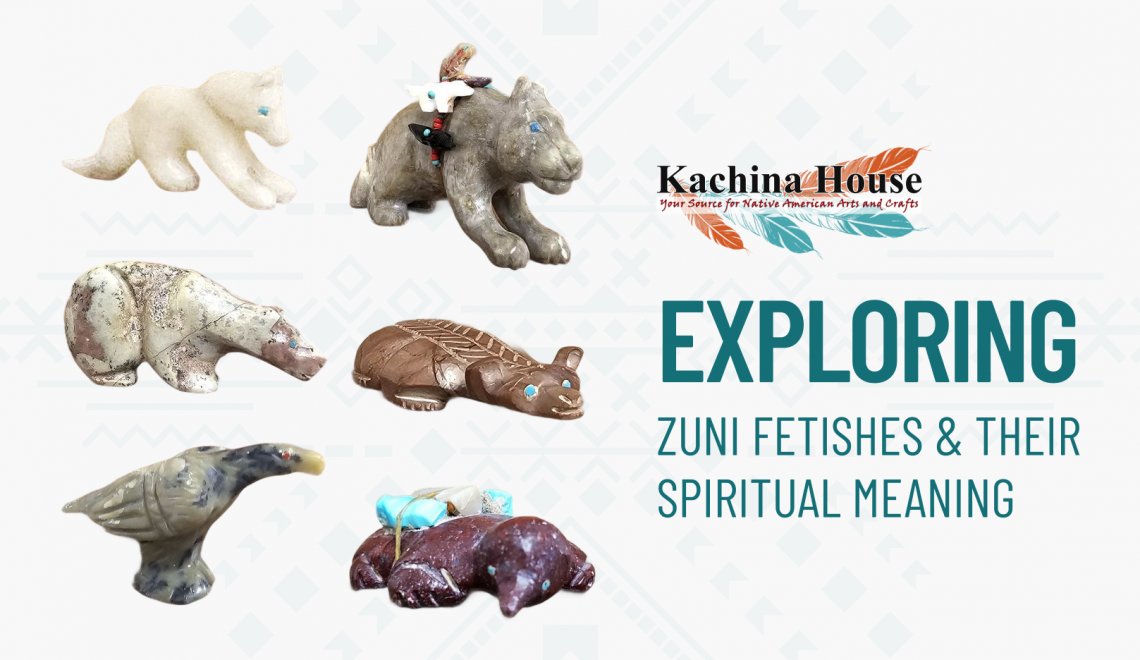
Step into the world of the Zuni of New Mexico, and you will discover a remarkable tradition of miniature carvings known as fetishes. These small, beautifully carved objects are more than just works of art. They are a bridge to the spiritual world of the Zuni, carrying cultural meaning that is passed down through generations. Each carving is a unique expression of artistry, belief, and the Zuni’s profound connection to the natural world.
For those new to this art form, Zuni fetishes can seem mysterious. This guide explores their traditional purpose, the fine craft involved in their creation, and the important distinction between a ceremonial fetish and a carving made for art enthusiasts.
The Origins of Zuni Fetishes
Zuni fetishes trace their roots to the tribe’s emergence and creation stories. According to Zuni cosmology, the world has six sacred directions: north, west, south, east, above, and below. Each direction has a guardian animal, called a Prey God, that protects its region.
These animals are considered masters of their domain and offer unique powers.
- North: Guarded by the Mountain Lion , (yellow) the elder of all animals.
- West: Guarded by the Bear, (blue).
- South: Guarded by the Badger, (red).
- East: Guarded by the Wolf, (white).
- Heavens (Above): Guarded by the Eagle, (multicolored).
- The Underworld (Below): Guarded by the Mole or Shrew, (black).
These guardian spirits form the foundation of Zuni fetish tradition. Carved representations serve as mediators between human and animal worlds. Within Zuni culture, these carvings hold animal spirits that offer guidance, protection, and healing.
What is Their Traditional Purpose?
Historically, Zuni fetishes served essential ceremonial purposes within tribal life. Hunters carried sacred objects of prey during expeditions. They believed animal spirits within would ensure successful hunts. The fetishes were held by designated “Keepers” who performed elaborate ceremonies.
During hunting rituals, clay pots containing fetishes were presented facing the guardian animal’s direction. Sacred medicine meal was sprinkled while prayers were recited. The chosen fetish was placed in buckskin and carried over the hunter’s heart. After successful hunts, fetishes were fed with prey blood as gratitude offerings.
Different fetish types served various spiritual purposes. The Priesthood of the Bow used special fetishes for travel protection. Medicine societies employed them in healing ceremonies. Some belonged to individuals, others to clans, and some to entire tribes.
Fetish vs. Carving: What’s the Difference?
This is a key question for anyone interested in collecting Zuni carvings. While the term “Zuni fetishes” is widely used for all carvings, there is a significant distinction between a ceremonial object and a contemporary carving.
A true fetish is a sacred object that has been blessed by a Zuni spiritual leader. These items are used in religious ceremonies and are not intended to leave the Zuni village. They are active spiritual tools for the carver or the person for whom they were made. Their power is integral to their purpose, and they are cared for with specific rituals, such as ceremonial feedings of cornmeal.
The beautiful figures available to collectors are more accurately described as Zuni carvings. These pieces are made by Zuni artists with the same incredible skill and attention to detail, but they are created as works of art for a secular audience. They carry the spirit of the Zuni artistic tradition but are not intended for ceremonial use. Many artists prefer the term “carving” to describe the works they sell to honor the sacredness of the true fetish.
The Artistry of Zuni Carvings
Zuni artists are masters of their craft, creating detailed figures entirely by hand. Carvers use a variety of materials and tools,, many of which are locally sourced or acquired through trade.
Common materials include:
- Serpentine: A local stone found in the Zuni Mountains.
- Turquoise: Considered the sacred stone by the Zuni people.
- Jet, Coral, and Shell: Often used for color and spiritual significance.
- Other Stones: Marble, pipestone, jasper, and travertine are also popular.
- Organic Materials: Antler, bone, and fossilized ivory add unique character.
Many carvings feature special adornments. You may see a painted or inlaid “heartline,” an arrow leading from the mouth to the heart that symbolizes the animal’s life breath or spirit. Some carvings carry a “medicine bundle,” a small offering of beads, arrowheads, or other items tied to the animal’s back to enhance the animal’s power and allow its prayers to be heard more easily..
Cultural Significance Today
Zuni carvings connect us to indigenous wisdom and natural spirituality. Whether displayed as art, appreciated for craftsmanship, or carried in one’s pocket, they remind us of our connection to the natural world.
The tradition represents one of North America’s most enduring spiritual art forms. Through contemporary carvers’ skilled hands, ancient wisdom finds expression in natural materials. They create bridges between past and present, sacred and secular worlds and humans and animals.
Discover Authentic Native American Art
The intricate world of Zuni fetishes represents just one facet of Native American artistic expression. From the ceremonial significance of carved guardians to vibrant Kachina doll traditions, indigenous artisans create works celebrating cultural heritage.
Ready to explore Native American art and spirituality? Discover an exceptional collection of Zuni fetishes and traditional crafts at Kachina House.


I’ve always found Zuni fetishes fascinating because they serve both as works of art and as spiritual tools. I like how you highlighted the idea that each animal carries its own meaning — it makes me think more intentionally about the energy or guidance I’d want to invite into my own space. Do you know if the Zuni have specific ceremonies for blessing or activating these fetishes, or is it more of a personal practice?
The Zuni people, in order to make the carvings actual religious/spiritual fetishes have specific ceremonies and specific people that bless the pieces. As an outsider, if you treat the carving with respect, including providing corn meal for it to eat, it will aid you in your journey.
This article just looks awesome! Both clear and informative, I really enjoy it. Thanks for sharing this amazing blog with us!